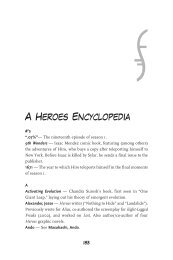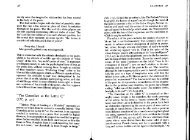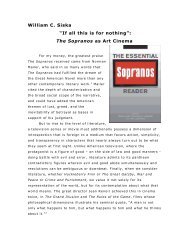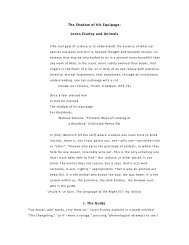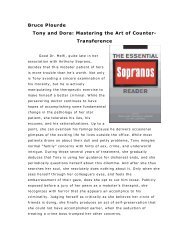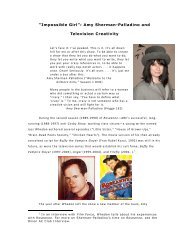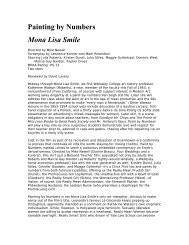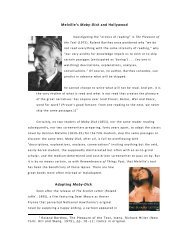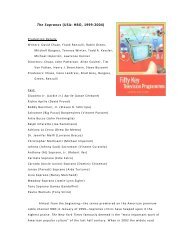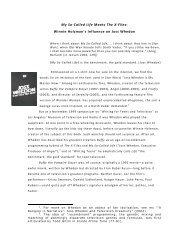Tinky Winky's got a brand new bag”: The Year's Work ... - David Lavery
Tinky Winky's got a brand new bag”: The Year's Work ... - David Lavery
Tinky Winky's got a brand new bag”: The Year's Work ... - David Lavery
You also want an ePaper? Increase the reach of your titles
YUMPU automatically turns print PDFs into web optimized ePapers that Google loves.
<strong>Tinky</strong> Winky’s <strong>got</strong> a <strong>brand</strong> <strong>new</strong> <strong>bag”</strong>: <strong>The</strong> <strong>Year's</strong> <strong>Work</strong> in<br />
Teletubbies Studies<br />
By Krystal Whitecastle, Impoverished State University<br />
Since its inception in 1997, Teletubbies studies has attracted its critics, many of whom argue that<br />
recent scholarship has failed to maintain the momentum established by Aristotle Anopheles's<br />
groundbreaking monograph Tele(ological)tubbies (Athens A&M UP, 1997). To be sure, there<br />
have been more lows than highs in recent years, and detractors have been eager to dwell upon<br />
the former [e.g., Mary Elizabeth Grace’s disappointing <strong>Tinky</strong> Winky, I Wuv You! (Scholastic P,<br />
1999) and Timmy Wilson’s intriguing but poorly-executed Po! Laa-Laa! Fall Down Again! (Mother<br />
Goose P, 2000)], while overlooking the latter [most notably Gerund Umlaut’s provocative inquiry,<br />
Entschuligen Sie, bitte, wie komme ich zum Land Teletubby? (Berlin: die Presse einfältig<br />
Universität, 1999)]. However, the intellectual vigor and critical sophistication of this year's work in<br />
Teletubbies studies should silence even the most skeptical critic of our discipline, for these works<br />
act as mental Viagra on minds left flaccid by the puerile criticism of Grace, Wilson, and their<br />
ineffectual ilk.<br />
Felix Culpa’s book “<strong>The</strong>re You Go Again! Again! Again!”: <strong>The</strong> Politics of Repetition and<br />
<strong>The</strong> Repetition of Politics (Bora Bora Institute of Technology P) opens with an ingenious<br />
metaphor: “On election night 2000, the nation’s voters collectively shouted, “Again! Again!” before<br />
falling hysterically to the ground. <strong>The</strong> <strong>new</strong> administration, in turn, replied, ‘Let them eat<br />
tubbytoast’” (vii). Contending that Teletubbies put George W. Bush in the White House, Culpa<br />
argues that the show's highly-repetitive nature subliminally conditioned millions of parents to find<br />
security in mindless repetition, thus causing them to vote for the candidate who subconsciously<br />
reminded them of their carefree high school and college years spent during the Reagan-Bush<br />
administrations. <strong>The</strong> American electorate, Culpa explains,<br />
displayed an infantile desire to turn back the clock and return to the benevolent<br />
paternalism of the Reagan-Bush years; repeated exposure to Teletubbies conditioned<br />
voters to find comfort and security in tax cuts for the wealthy, increased spending for<br />
defense, and the opening of protected wildlife preserves for oil exploration. (64).<br />
Culpa’s argument is an ingenious one, and if correct, Tony Blair had better keep a wary eye on<br />
Margaret Thatcher.<br />
2001 saw the publication of the much-anticipated reference work, “I am not a number. I<br />
am a Teletubby”: <strong>The</strong> Prisoner and Teletubbies by Paddy Fritz and Joseph Serf (Village<br />
Publications). Fritz and Serf, co-authors of last year’s critically-acclaimed Spongebob<br />
Squarepants and the Geometry of Style (Atlantis UP), have produced an impressive three-volume<br />
work enumerating 46,023 parallels between Patrick McGoohan’s 1967 television series and<br />
Teletubbies, ranging from the seemingly trivial (the license plate on the Prisoner’s Lotus 7 Series<br />
II reads “KAR12OC,” which is also the Noo-Noo’s serial number) to the profound (in both shows<br />
characters are confined in an idealized English landscape and controlled by anonymous voices<br />
heard over a network of loudspeakers, both shows feature giant weather balloons that sometimes<br />
pursue the protagonists, and both shows unarguably function on an allegorical level). This book is<br />
an outstanding example of Teletubbies scholarship and essential reading for anyone interested in<br />
the astonishing influence of British television upon British television.<br />
A welcome addition to the growing corpus of Teletubbies influence studies is “Fear no<br />
more the heat of the baby-faced sun”: Teletubbies and Early Modern Drama (Dismal State UP,<br />
2001) by M. Minkoff-Reilly, Indentured Instructor of English at l’Université de Nouvelle Orléans.<br />
Minkoff-Reilly argues that early modern drama constitutes the single-greatest influence upon<br />
Teletubbies, and her work thus stands as a bold challenge to Percy Porlock's hypothesis<br />
[presented in his 1998 book We All Live in a Stately-Pleasure Dome: <strong>The</strong> Magical History of<br />
Teletubbies (Liverpool UP)] that English Romanticism and late 1960s British psychedelia were
the primary sources of inspiration for the popular children's program. Minkoff-Reilly acknowledges<br />
this fact in her introduction:<br />
<strong>The</strong> influence of Romanticism, especially ‘Kubla Khan,’ and Yellow Submarine-era Beatles upon<br />
Teletubbies cannot be overstated; however, if Porlock had spent less time in that Amsterdam<br />
coffeehouse “researching” his book, he would have realized that early modern drama exerts an<br />
even greater influence. (ix)<br />
Viewing Teletubbies through the lens of early modern drama is an approach which produces<br />
intriguing but inconsistent results. For example, Minkoff-Reilly's assertion that Po and Laa-Laa<br />
were based upon Rosencrantz and Guildenstern lacks concrete evidence, while her suggestion<br />
that a computer-animated sequence in which a nattily-dressed bear emerges from a flying<br />
carousel to perform a soft-shoe dance routine “was undoubtedly inspired by the stage direction<br />
‘Exit, pursued by a bear’ in <strong>The</strong> Winter’s Tale” is just plain wrong.<br />
<strong>The</strong> arguments that do work, however, work very well indeed. For instance, Minkoff-Reilly<br />
offers what may well prove to be the definitive reading of the classic sequence in which a giant<br />
blowout party favor tickles <strong>Tinky</strong> Winky’s buttocks as he bends over. After examining several<br />
examples of this type of anality in early modern drama, she concludes: “Like Hodge in Gammer<br />
Gurton’s Needle and Edward II in Marlowe’s play, it is safe to say that <strong>Tinky</strong> Winky gets it in the<br />
end” (34). In another chapter Minkoff-Reilly challenges Porlock’s assertion that “Teletubbyland<br />
exists somewhere slightly west of Xanadu but north-northeast of Pepperland” (567), arguing<br />
instead that Teletubbyland has more in common with the homes of Puck and Ariel:<br />
<strong>The</strong>re is no denying that Teletubbyland is a magical place, but while Porlock recognizes a<br />
pharmaceutical source of the magic, I prefer to regard Teletubbyland as part of the same<br />
mythopoetic landscape as the Athenian forests of A Midsummer Night’s Dream and<br />
Prospero’s island in <strong>The</strong> Tempest, places inhabited by playful sprites and loveable<br />
faeries, not women wailing for their demon lovers and Blue Meanies. (134)<br />
<strong>The</strong>se arguments alone make the book an invaluable contribution to the field, “but wait,” as the<br />
sponsors are wont to say, “there’s more”: Minkoff-Reilly saves the best for last, concluding her<br />
monograph with a provocative and challenging reinterpretation of what many Teletubbies<br />
scholars generally regard as our darkest hour. I speak, of course, of Reverend Jerry Falwell’s<br />
infamous “outing” of <strong>Tinky</strong> Winky.<br />
In 1999 Falwell’s National Liberty Journal warned parents that <strong>Tinky</strong> Winky is a gay role<br />
model. Foremost among the evidence for this startling assertion is the fact that the male <strong>Tinky</strong><br />
Winky carries a purse; furthermore, the article asserts, “He is purple—the gay pride color; and his<br />
antenna is shaped like a triangle—the gay pride symbol” (“<strong>Tinky</strong> Winky Comes Out of the<br />
Closet”). Although Falwell himself did not write the article, he later told reporters that he stood<br />
behind it, adding, "As a Christian I feel that role modeling the gay lifestyle is damaging to the<br />
moral lives of children” (“Falwell’s”). Falwell’s fear that exposing young boys to <strong>Tinky</strong> Winky would<br />
turn them into mincing queens struck most people as ludicrous, and satirists were quick to ridicule<br />
the former leader of the Moral Majority. However, Minkoff-Reilly argues, these satirists were<br />
nearly four centuries too late, for a character based upon Falwell had already been lampooned by<br />
Ben Jonson in Bartholmew Fair (1614). Near the end of the play, a puritan minister named Zealof-the-Land<br />
Busy interrupts a puppet show, charging both the audience and the puppets with<br />
immorality. Busy then enters a debate with one of the puppets, which culminates thus:<br />
BUSY. Yes, and my main argument against you is that you are an abomination; for the<br />
male among you putteth on the apparel of the female, and the female of the male.<br />
PUPPET DIONYSIUS. You lie, you lie, you lie abominably. . . . It is your old stale<br />
argument against the players, but it will not hold against the puppets, for we have neither<br />
male nor female amongst us. And that thou may’st see, if thou wilt, like a malicious<br />
purblind zeal as thou art!<br />
<strong>The</strong> puppet takes up his garment.<br />
BUSY. I am confuted, the cause hath failed me. (5.5.87-101)
Jonson, Minkoff-Reilly insists, satirizes Falwell’s attack on <strong>Tinky</strong> Winky by having Busy lose a<br />
debate with a puppet over its alleged sexual orientation.<br />
Proving that Jonson had foreknowledge of the event proves to be Minkoff-Reilly’s biggest<br />
challenge, yet she rises to the occasion, offering unassailable proof:<br />
While composing Bartholmew Fair in 1614, Jonson met Michel de Nostradamus at a dinner party<br />
hosted by Lucy, Countess of Pembroke, and the celebrated French astrologer was so charmed<br />
by Jonson’s wit that he gifted him with the following quatrain, which I discovered by chance on Ebay:<br />
<strong>The</strong> shepherd shall lead his flock astray<br />
By finding evil in a child’s plaything;<br />
Yet his argument will reveal his own folly—<br />
When confuted, he will fall well. (486)<br />
Minkoff-Reilly rightly concludes that through this prophetic verse, Jonson foresaw Falwell’s<br />
ridiculous attempt to impose human sexual orientation upon genderless fictional creatures and<br />
decided it would be good for a laugh or two on stage.<br />
Although using Nostradamus to support her argument will certainly generate controversy,<br />
it is exactly this type of scholarly risk-taking needed to push the boundaries of Teletubbies studies<br />
(after all, Mary Elizabeth Grace and Timmy Wilson didn’t exactly take any chances). Aware that<br />
her thesis is a challenging one, Minkoff-Reilly strongly defends her position:<br />
Although some small-minded nitpickers and Skeptical Inquirer-types will demand to know<br />
how Falwell’s actions could have influenced Jonson’s play 385 years earlier, my<br />
response is that the influence is undeniably there. As any fool can plainly see, Falwell’s<br />
homophobic attack upon the Teletubbies so closely parallels Busy’s attack upon the<br />
puppets that one cannot ignore the obvious influence of Teletubbies upon Bartholmew<br />
Fair. End of story. Deal with it. (335)<br />
Indeed, just as Busy could not refute the puppet’s logic, this reviewer cannot refute Minkoff-<br />
Reilly’s ingenious argument.<br />
Given my obvious admiration for Minkoff-Reilly’s book, it may come as a surprise that as<br />
awe-inspiring as her book is, there is an even more powerful work left to review. Not an influence<br />
study but a relentlessly post-modern analysis of race and racism in Teletubbies, the book raises<br />
many questions, but, like an elusive enigma wrapped in a cryptic mystery shrouded in an esoteric<br />
riddle, it provides few answers. Even the identity of the author is unknown. <strong>The</strong> book of which I<br />
speak is, of course, the anonymous Coloring the Teletubbies (Smith-Binney Publications). This<br />
crucial book bridges the perceived gulf between racial and individual identity, challenging our<br />
(pre)conceptions about how racial identity is imagined, inscribed, figured, and theorized in<br />
Teletubbies.<br />
<strong>The</strong> anonymous author employs a series of linked black and white drawings printed on<br />
coarse <strong>new</strong>sprint to investigate race in Teletubbyland and, by extension, our own. Since these<br />
pictures cry out for color, the author's intent in rendering them monochromatically has generated<br />
much scholarly debate: Does the absence of color indict Teletubbies for racism? Or does this<br />
absence of color in fact invite us to project upon each Teletubby our own racial construction? For<br />
years to come Coloring the Teletubbies will remain essential reading for professional scholars<br />
and critics writing about Teletubbies. For the sake of Teletubbies studies, let us hope that this<br />
anonymous author is busily working on Gendering the Teletubbies and Classing the Teletubbies.<br />
<strong>Work</strong>s Cited<br />
“Falwell’s Newspaper Claims ‘Teletubbies’ Character is Gay.” CNN Interactive. 10 Feb. 1999. 23<br />
May 2001. .<br />
Jonson, Ben. Bartholmew Fair. Ed. G. R. Hibbard. New Mermaids. New York: Norton, 1977.
“<strong>Tinky</strong> Winky Comes Out of the Closet.” NLJ Online. Feb. 1999. 23 May 2001.<br />
.




